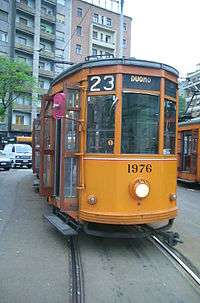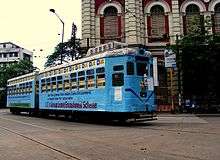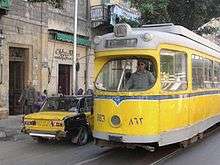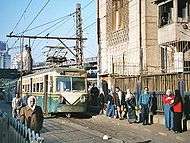Tram and light rail transit systems
Although tram systems date to the late 19th and early 20th centuries, many old systems were closed during the mid-20th century because of the advent of automobile (incl. bus) travel. This was especially the case in North America, but postwar reductions and shutdowns also occurred on British, French and other Western European urban rail networks. However, traditional tramway systems survived, and eventually even began to thrive from the late 20th century onward, some eventually operating as much as when they were first built over a century ago. Their numbers have been augmented by modern tramway or light rail systems in cities which had discarded this form of transport.

Europe
Much tramway infrastructure was lost during the mid-20th century in many European cities, although not on the same scale as in other parts of the world (such as North America). Most of Eastern Europe retained tramway systems until recently, but some cities are reconsidering their transport priorities. Some Western European cities are rehabilitating, upgrading, expanding and reconstructing old tramway lines, and many Western European towns and cities are building new tram lines.
North America
In North America (especially the United States), trams are generally known as streetcars or trolleys; a "tram" is a tourist trolley, an aerial tramway or a people mover. Streetcar lines were largely torn up during the mid-20th century for a variety of financial, technological and social reasons, and comparably few exist today. The Sistema de Tren Eléctrico Urbano in Guadalajara, Mexico has the highest annual ridership among light rail systems in North America.
Canada
Most of the country's streetcar systems disappeared after World War II, giving way to buses:
- Windsor (1937)
- Kitchener Public Utilities Commission (1946)
- North Vancouver (1947)
- Nova Scotia Light and Power Company, Limited, Halifax (1949)
- Edmonton Radial Railway, Saskatoon Municipal Railway and Hamilton Street Railway (1951)
- Vancouver (1955)
- Ottawa Transportation Commission and Montreal Tramways Company (1959)
Toronto's system grew with the abandonment of streetcar operations in the United States and the rest of Canada, as the Toronto Transit Commission purchased cars from many former operators. The Toronto system grew to become the largest streetcar system in the Americas.
During the late 20th century, several cities installed light rail systems (partially along the same corridors as the streetcars). Some have restored their old streetcars and run them as a heritage ride for tourists; an example is the Vancouver Downtown Historic Railway.
United States
Horsecars were in use on New York City streets as early as 1832,[1] and the St. Charles Avenue Line of New Orleans' streetcar system is the oldest continuously operating street railway system in the world, beginning operation as a horse-drawn system in 1835.[2] Motive power was eventually largely transitioned to steam engine-hauled locomotives, then in 1873 the first practical cable car line was tested in San Francisco. As electric traction became popular, streetcar and interurban systems proliferated across the United States. Passenger interurban railways had largely declined in use by the late 1920s. The Great Depression led to the closure of many streetcar lines, but World War II stopped the closure of many systems as they provided transportation during a time when gasoline and rubber tires were rationed. Pittsburgh kept most of its streetcar system (serving the city and many suburbs) until January 27, 1967, making it the longest-lasting large-network U.S. streetcar system.
Exceptions to streetcar closures of the 1960s included the cities of New Orleans, Newark, Seattle, Philadelphia, Boston, and San Francisco. These systems generally had more lines and larger service areas which were replaced by buses or largely scaled back. These surviving "legacy" systems generally used preexisting tunnels, had exclusive right of ways, or were upgraded to light rail specifications around the 1980s.
The San Diego Trolley inaugurated service in 1981 as the first newly built light rail system in the United States since the 1950s. The American Public Transportation Association counts 33 light rail systems operating in the country as of 2019.[3]
Central America
Panama
Trams in Panama predate the country's founding; electric tram service began in 1893 in Panama City, in what was then Colombia. In 1913, cable cars began operating in Colon. Panama Metro began operating the first subway in mainland Central America, a 12-station system, on April 5, 2014.[4]
Guatemala
Metro Riel is the name given to the light rail system proposed for Guatemala City.
Nicaragua
Managua LRT is the name to the given light rail system proposed for Managua.
South America
Argentina
Buenos Aires (once known as the City of Trams) had one of the world's most extensive networks, with over 857 km (535 mi) of track.[5] Most of it was dismantled during the 1960s in favor of bus transportation.
The Anglo-Argentine Tramways Company opened Latin America's first underground tram system, Subte Line A, in 1913. The original route was underground and at street level until 1926, and pantograph cars—built by La Brugeoise in Belgium—had low doors at the ends (for boarding from the street) and high doors in the middle (for boarding from a tunnel platform). Subte Line A is arguably one of the continent's first light metros. The vintage carriages (without the end doors) remained in operation until 2013.
Using Line A's surface non-revenue tracks in the Caballito neighborhood, the Asociación Amigos del Tranvía (Friends of the Tramway Association)[6] operates a heritage streetcar service with restored tram and metro cars on weekends and holidays from the Polvorín Workshop. The Tren de la Costa (Coastal Train), a light-rail service running on a right-of-way formerly used from 1891 to 1961, began in 1995. Serving tourists and commuters, it runs from the northern suburbs of Buenos Aires to Tigre along the Paraná River for about 15 kilometres (9.3 mi). The PreMetro E2 operates as a feeder at the end of Metro Line E in the western suburbs. In central Buenos Aires, the Tranvía del Este (or Puerto Madero Tramway) was an experimental tramway which operated on a 2-kilometre (1.2 mi) route in the Puerto Madero District from 2007 to 2012 with a single-car Alstom Citadis tram—two cars during the first year—on loan from Madrid. Planned extensions did not come to fruition, and low ridership led to a decision to discontinue service. The 12.6-kilometre (7.8 mi) Metrotranvía Mendoza (Mendoza Light Rail) opened for regular service in the city of Mendoza in October 2012, operating on relaid tracks on a former Ferrocarril General San Martín mainline right-of-way with LRVs (light-rail vehicles) acquired from San Diego, California.[7]
Brazil
Brazil has the largest light-rail network in Latin America, with new systems under construction. Rio de Janeiro has the largest system, with three lines, 42 stations and 30 kilometres (19 mi) of rail lines. Santos, Maceio, Fortaleza, Recife, Cariri, Sobral and Cuiaba also have light rail. The city of Santos has a 12-kilometre (7.5 mi) line with 15 stations. Fortaleza has a 20-kilometre (12 mi), 10-station line. Recife has two lines with nine stations each and 32 kilometres (20 mi) of track. Sobral has a 12-station, 14 kilometres (8.7 mi) line. The nine-station, 14-kilometre (8.7 mi) Cariri Light Rail connects the twin cities of Crato and Juazeiro do Norte. Maceió has a 15-station, 35-kilometre (22 mi) line. Cuiabá, with two lines, 23 kilometres (14 mi) of track and 33 stations, is in the final stages of implementing its light-rail system.
Ecuador
The Ecuadorian city of Cuenca's first tram line will opened in May 2020.
Asia

Although tram systems were well-established in Asia at the start of the 20th century, they began a steady decline during the mid to late 1930s. The 1960s marked the end of the continent's dominance in public transportation, with most major systems closed and their equipment and rail sold for scrap; however, a number of systems continue to operate in the Russian Far East and Japan. Kolkata has Asia's oldest operating electric tram system which currently runs 6 routes, operating since 1902. There is rekindled interest in tram transport with surviving systems being upgraded and new systems being constructed. In China, several new systems have opened in the past few years with several more under construction.
The first Japanese tram line began in 1895 as the Kyoto Electric Railroad. The tram reached its zenith in 1932, when 82 rail companies operated 1,479 kilometres (919 mi) of track in 65 cities. Its popularity declined during the rest of the decade, a trend accelerated by the Pacific War, the occupation of Japan and the rebuilding years. Although many of the remaining tramways were shut down and dismantled in favor of auto, bus, and heavy rail service during the 1960s, A few tram systems remained in smaller Japanese cities.
Australasia
.jpg)
In Australasia, trams are used extensively in Melbourne; all other major cities largely dismantled their legacy networks by the 1970s. Adelaide retained one line between the city and Glenelg (which has been extended), and work on a new line is in progress.
Sydney reintroduced tram service on the Dulwich Hill Line in 1997, with a second CBD and South East Light Rail line opened in 2019. A new Parramatta Light Rail line is currently under construction and will add to light rail in Sydney however will be separate from the other Sydney light rail lines.
The 2010s saw increased investment in new light rail construction with the Gold Coast opening the G:link in 2014, Canberra opening its first light rail line in 2019 and Newcastle opening a new line also in 2019.
Ballarat, Bendigo, Christchurch and Auckland have reintroduced trams as heritage operations.
A distinctive feature of many classic Australasian trams was their early use of a lowered central section between bogies (wheel sets), intended to make passenger access easier by reducing the number of steps required to reach the inside of the vehicle. Cars with this feature were known as "drop-centres".
Africa
Egypt


Although Cairo and Alexandria have historic systems which still exist, the once-extensive Cairo urban system is nearly defunct. The express tram line to and within Masr el-Djedida (Heliopolis) is still in operation. It is an example of a surviving interurban electric railway, the ancestor of light rail. A small 1970s system in the city of Helwan, 25 kilometres (16 mi) south, is still operational. Some of Cairo's cars are former Toronto Transit Commission PCC streetcars.
Alexandria's urban system and express routes to its eastern suburbs are still in operation. The urban system operates yellow cars (including some acquired from Copenhagen), primarily on street track. The express system (Ramleh routes) operates three-car blue trains, including some double-deck cars, on largely reserved track. There are also some dual-system routes.
Ethiopia
In Ethiopia, construction by China Railway Group Limited was ongoing on Addis Ababa Light Rail in 2013.[8] The Ethiopian Railway Corporation began construction of the 34.25-kilometre (21.3 mi) double-track electrified light rail project in December 2011, funded by the Export-Import Bank of China.[9] Initially, the system would have two lines. The project was expected to take three years to complete,[8] and trial operations began in early 2015.[10]
Mauritius
In Mauritius, the Metro Express light rail system was inaugurated in 2019, and opened for general use in January 2020. This was the first rail system to operate on the island since the closure of the heavy rail system in the 1960s.[11]
Nigeria
Abuja's light rail network began operation in 2018, the first of its kind in West Africa.
Tunisia
Tunis had traditional trams until about 1960. A new light-rail line began operation in 1985, and has been followed by other systems.
South Africa
Public transport in South Africa began in Cape Town in May 1801, when a weekly coach service to Simon's Town was announced. The Cape's first horse-drawn omnibus was introduced, based on George Shilbeer's model. The Cape Town and Green Point Tramway Company was formed in September 1862, and began operations on April 1, 1863.
Single- and double-deck horse-drawn trams were used. Cape Town's electric tram system initially had ten cars which were built in Philadelphia. Lady Sivewright, the wife of James Sivewright, opened the new system on August 6, 1896. At the time of Queen Victoria's Diamond Jubilee in 1897, Cape Town and its suburbs had 32 electric trams running on about 23 miles (37 km) of track. The new power station was inadequate, and had to be expanded. Tram service also existed in Pretoria, Durban and Johannesburg (where the Rand Tram, the suburban railway to Boksburg, opened in 1890), but were replaced by petrol, diesel and trolleybus systems by the early 1960s.
World's largest tram systems
| Nr | City | Length (km) | Stops | Lines | Ridership (million/year) | Fleet | Info year |
|---|---|---|---|---|---|---|---|
| 1 | Melbourne | 250 | 1763 | 24 | 206 | 500 | 2018[12] |
| 2 | Moscow | 208[Note 1] | 44 | 220 | 825 | 2015[13] | |
| 3 | Saint Petersburg | 205.5 | 41 | 312[Note 2] | 781 | 2011 | |
| 4 | Cologne | 198 | 233 | 12 | 211 | 382 | 2016 (2013 Nr. of vehicles) |
| 5 | Berlin | 193.6 | 803 | 22 | 197 | 2017 | |
| 6 | Milan | 180.2 km (112.0 mi)[14] | 19[14] | 493[14] | 2019[14] | ||
| 7 | Vienna | 177 | 1071 | 30 | 305 | 525 | 2013[15] |
| 8 | Los Angeles | 158.5 | 4 | 352 | 2017 | ||
| 9 | Budapest | 156.85 | 671 | 40[Note 3] | 396 | 520 | 2011[16] |
| 10 | Sofia | 154[Note 4] | 165 | 15 | 176 | 2006[17][18] | |
| 11 | Leipzig | 146 | 522 | 15 | 134 | 245 | 2016[19] |
| 12 | Prague | 142.4 | 596 | 31 | 373 | 857 | 2017[20][21] |
| 13 | Brussels | 139 | 19 | 123 | 349 | 2011[22] | |
| 14 | Bucharest | 139 | 598 | 24 | 322 | 483 | 2013[23] |
| 15 | Dresden | 134.3 | 259 | 12 | 145 | 2018 | |
| 16 | Stuttgart | 131 | 201 | 17 | 170 | 204 | 2016 |
| 17 | Warsaw | 130.5 | 26 | 328 | 763 | 2016[24] | |
| 18 | Hanover | 127 | 197 | 12 | 176 | 2016 | |
| 19 | Zürich | 122.7 | 14 | 212 | 258 | 2018[25] | |
| 20 | The Hague | 117 | 239 | 10 | 68 | 279 | 2016 |
| 21 | Zagreb | 116 | 256 | 15 (day) + 4 (night) | 214 | 204 | 2008 |
| 22 | Manchester | 100 | 93 | 8 | 43.7 | 120 | 2019[26] |
| 23 | Gothenburg | 95 | 132 | 13 (One of the lines is a heritage tram line)[27] | 140[28] | 263[29] | 2018 |
| 24 | Toronto | 82 | 708 | 11 | 64 | 247 | 2012[30] |
| 25 | Amsterdam | 80.5 | 500 | 15 | 130 | 200 | |
| 26 | Munich | 80.4 | 172 | 13 | 105 | 113 | 2013 |
See also
- List of tram and light rail transit systems (existing, regular public-transit systems)
- List of town tramway systems (includes closed systems)
Notes
- This reference ("Евгений Михайлов: Обособление трамвайных путей положительно сказывается на регулярности движения наземного городского транспорта" [Yevgeny Mikhailov: The separation of tramways' positive impact on the reliability of urban transport traffic] (in Russian). Мосгортранс [Mosgortrans]. March 17, 2014. Retrieved March 6, 2015.) quotes the 2014 single track length of Moscow's tram network to be 416 kilometres (258 mi) – for the purposes of this table, the double track system length of Moscow's tram network is assumed to be roughly half that figure, or approximately 208 kilometres (129 mi).
- Estimate
- normal: 35; night: 1; heritage: 3; temporary: 1
- This reference ("Urban transport – History of Sofia Trams". Sofia Urban Mobility Center. 2015. Retrieved March 1, 2015.) quotes the 2006 single track length of Sofia's tram network to be 308 kilometres (191 mi) – for the purposes of this table, the double track system length of Sofia's tram network is assumed to be roughly half that figure, or approximately 154 kilometres (96 mi).
References
- The John Stephenson Car Co. Retrieved 25 February 2009.
- "About the RTA". New Orleans Regional Transit Authority. Retrieved May 14, 2013.
- "Transit Ridership Report: Third Quarter" (PDF). American Public Transportation Association. Retrieved March 7, 2020.
- Etoniru, Nneka; Leme, Luisa; Glickhouse, Rachel (April 21, 2013). "On the Rails in Panama City: Central America's First Metro Unveiled". Americas Society – Council of the Americas.
- www.tranvia.org.ar Archived July 28, 2013, at the Wayback Machine Apuntes sobre la Historia Del Tranvía en Buenos Aires(Spanish) Information and photographs – accessed October 25, 2010
- www.tranvia.org.ar Association of Tramway Friends – accessed December 10, 2008
- "Mendoza light rail service begins" (December 2012). Tramways & Urban Transit, p. 451. UK: LRTA Publishing.
- "Addis Light Rail Progress". Railways Africa. October 2, 2013. Retrieved November 25, 2013.
- "Corporation discloses/Addis light rail project detail". The Ethiopian Herald. March 10, 2013. Archived from the original on November 9, 2013. Retrieved October 25, 2014.
- "中国企业承建的埃塞俄比亚首都城市轻轨开始试运行(高清组图)" (in Chinese). February 2, 2015. Archived from the original on July 4, 2017. Retrieved March 18, 2018.
- https://www.railwaygazette.com/projects-and-planning/mauritius-metro-express-inaugurated/54844.article
- "Facts & figures" (PDF). Yarra Trams. 2018. Retrieved December 4, 2019.
- "О предприятии" [About the company] (in Russian). Мосгортранс [Mosgortrans]. Retrieved March 5, 2015.
- "Carta della mobilità ATM 2019" [ATM Mobility Charter 2019] (pdf) (in Italian). Azienda Trasporti Milanesi S.p.A. 2019. Retrieved May 17, 2020.
- "Unternehmen / Zahlen, Daten, Fakten / 2013" [Company Profile / Figures, Data, Facts / 2013] (PDF) (in German). Wiener Linien. 2013. p. 4. Retrieved February 28, 2015.
- "BKV.hu" (PDF). www.bkv.hu.
- "Urban transport – History of Sofia Trams". Sofia Urban Mobility Center. 2013. Retrieved March 1, 2015.
- "Route network of tram lines of Sofia's public transportation" (PDF). Sofia Urban Mobility Center. 2015. Retrieved March 1, 2015.
- "Statistisches Jahrbuch Leipzig 2017" (PDF).
- "Praha chce stavět tramvajové linky do středních Čech". Novinky.cz (in Czech).
- "Pražská MHD loni přepravila o 9,6 procent více cestujících. Využila ji více než miliarda lidí". Aktuálně.cz (in Czech). March 7, 2017.
- http://www.mivb.be/irj/go/km/docs/STIB-MIVB/INTERNET/attachments/Bilan_2011/STIB_FiguresStatistics_2011.pdf
- http://www.ratb.ro/docpdf/statistic_2013.pdf
- "Archived copy". Archived from the original on September 13, 2012. Retrieved September 13, 2012.CS1 maint: archived copy as title (link)
- "Zahlen & Fakten – Stadt Zürich". www.stadt-zuerich.ch.
- "Department for Transport, Light Rail and Tram Statistics, England, 2019" (PDF). https://assets.publishing.service.gov.uk. June 19, 2019. Retrieved October 11, 2019. External link in
|website=(help) - "Västtrafik, Linjenät (Line network)" (PDF). Retrieved December 7, 2019.
- "Västtrafik, Resandet ökar (Increase in ridership)". Retrieved December 7, 2019.
- "Göteborgs Spårvägar, Våra spårvagnar (Our Trams)". Retrieved December 7, 2019.
- http://www.ttc.ca/PDF/Transit_expansion_PDFs/Streetcar_network_Factsheet.pdf
External links
- A world of trams and urban transit (from Light Rail Transit Association (LRTA))
- UrbanRail.Net (website devoted to world metro and tram system from Robert Schwandl)